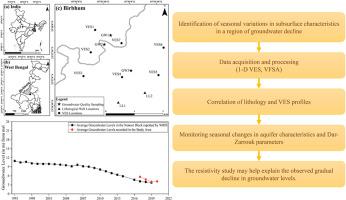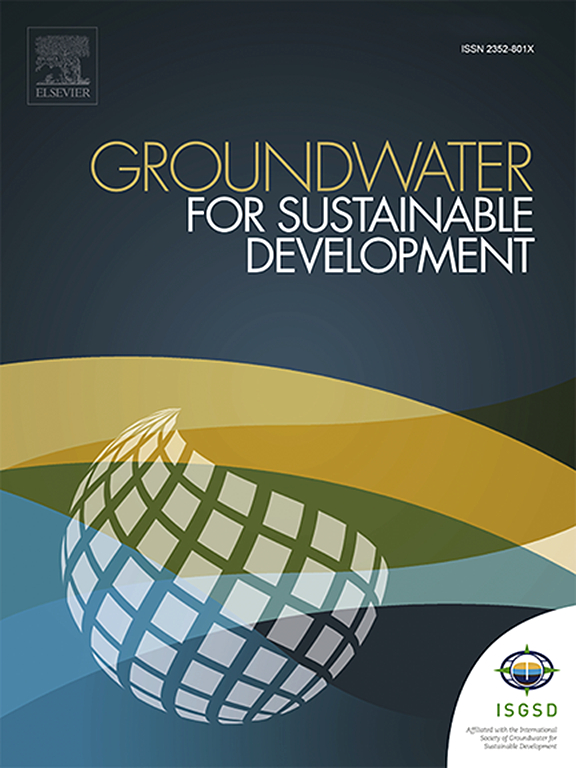下孟加拉盆地地下特征的季节性变化:对地下水的潜在影响
IF 4.9
Q2 ENGINEERING, ENVIRONMENTAL
引用次数: 0
摘要
如果在地下特征不利于地表水渗透和自然补给的地区人为抽取大量地下水,地下水枯竭的风险就会最大。然而,印度洋-甘地盆地是世界上最肥沃的冲积含水层之一,该盆地尚未系统地确定此类区域。通过研究地下特征的季节性变化对地下水位的影响,可以确定这些区域。我们在近几十年来地下水位急剧下降的下恒河盆地纳诺尔区块进行了电阻率勘测,以确定控制渗透和地下水质量的地下特征如何随季节变化。在季风前(2018 年 4 月)和季风后(2018 年 10 月)季节,使用斯伦贝谢电极阵列在 8 平方公里的区域内进行了垂直电测深(VES),电极间距为 180-200 米。评估了达尔扎鲁克参数的季节性变化:纵向电导、横向电阻和各向异性系数。虽然平均纵向电导率在不同季节保持不变,但在季风后的某些地点有所增加,这表明地表存在潜在的污染风险。季风后的横向阻力明显增大,表明地下水的潜力减小。此外,在某些地区,各向异性系数显示季风后覆土层的压实度增加,表明天然补给潜力下降。最后,从季风前到季风后,非饱和带的厚度显著增加,这可能是由于在哈里夫耕种季节抽取地下水进行灌溉所致。这些结果表明,该地区严重依赖地下水灌溉,其地表下特性使得自然补给潜力有限。这项研究可为发展中国家的地下水资源管理提供一个框架,在这些国家,人为抽取地下水对地下水位的影响可能比降雨特征变化导致的天然补给减少更为显著。本文章由计算机程序翻译,如有差异,请以英文原文为准。

Seasonal changes in subsurface characteristics in the Lower Bengal Basin: Potential impacts on groundwater
The risk of groundwater depletion is most significant if anthropogenic withdrawals are high in regions where the subsurface characteristics do not favor surface water infiltration and natural recharge. However, such regions have not been identified systematically in the Indo-Gangetic basin, one of the most fertile alluvial aquifers in the world. This identification may be enabled by a study of how seasonal changes in subsurface characteristics affect groundwater levels. We conducted a resistivity survey in Nanoor block of the Lower Ganges Basin, where groundwater levels have declined steeply in recent decades, to determine how subsurface characteristics controlling infiltration and groundwater quality may change seasonally. Vertical Electrical Soundings (VES) using the Schlumberger electrode array were conducted over an 8 km² area with an electrode spacing of 180-200 meters during the pre-monsoon (April 2018) and post-monsoon (October 2018) seasons. Seasonal variations in the Dar- Zarrouk parameters: longitudinal conductance, transverse resistance, and the coefficient of anisotropy were evaluated. While the average longitudinal conductance remained unchanged across seasons, it increased in certain locations in post-monsoon, indicating potential risks of contamination from the surface. The transverse resistance significantly increased in the post-monsoon, suggesting reduced groundwater potential. Additionally, in some areas, the coefficient of anisotropy indicated increased compaction of overburden layers in the post-monsoon, suggesting decreased natural recharge potential. Finally, the thickness of the unsaturated zone increased significantly from pre-monsoon to post-monsoon, which may be attributed to groundwater withdrawal for irrigation during the Kharif cropping season. These results indicate that this region, heavily reliant on groundwater for irrigation, is characterized by subsurface properties that allow limited natural recharge potential. This study may provide a framework for managing groundwater resources in developing countries where anthropogenic withdrawals are likely to have a more significant impact on groundwater levels than reduced natural recharge due to changing rainfall characteristics.
求助全文
通过发布文献求助,成功后即可免费获取论文全文。
去求助
来源期刊

Groundwater for Sustainable Development
Social Sciences-Geography, Planning and Development
CiteScore
11.50
自引率
10.20%
发文量
152
期刊介绍:
Groundwater for Sustainable Development is directed to different stakeholders and professionals, including government and non-governmental organizations, international funding agencies, universities, public water institutions, public health and other public/private sector professionals, and other relevant institutions. It is aimed at professionals, academics and students in the fields of disciplines such as: groundwater and its connection to surface hydrology and environment, soil sciences, engineering, ecology, microbiology, atmospheric sciences, analytical chemistry, hydro-engineering, water technology, environmental ethics, economics, public health, policy, as well as social sciences, legal disciplines, or any other area connected with water issues. The objectives of this journal are to facilitate: • The improvement of effective and sustainable management of water resources across the globe. • The improvement of human access to groundwater resources in adequate quantity and good quality. • The meeting of the increasing demand for drinking and irrigation water needed for food security to contribute to a social and economically sound human development. • The creation of a global inter- and multidisciplinary platform and forum to improve our understanding of groundwater resources and to advocate their effective and sustainable management and protection against contamination. • Interdisciplinary information exchange and to stimulate scientific research in the fields of groundwater related sciences and social and health sciences required to achieve the United Nations Millennium Development Goals for sustainable development.
 求助内容:
求助内容: 应助结果提醒方式:
应助结果提醒方式:


